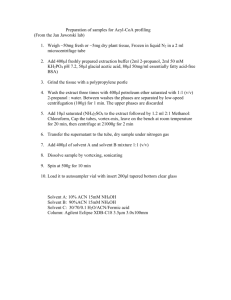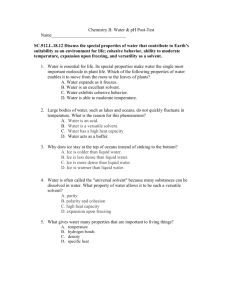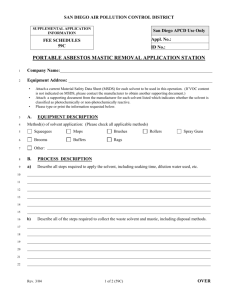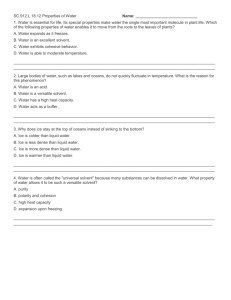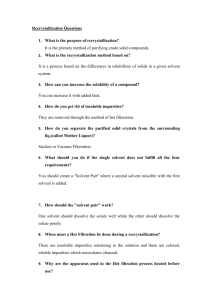Recrystallizing Of Unknown Impure Solids
advertisement
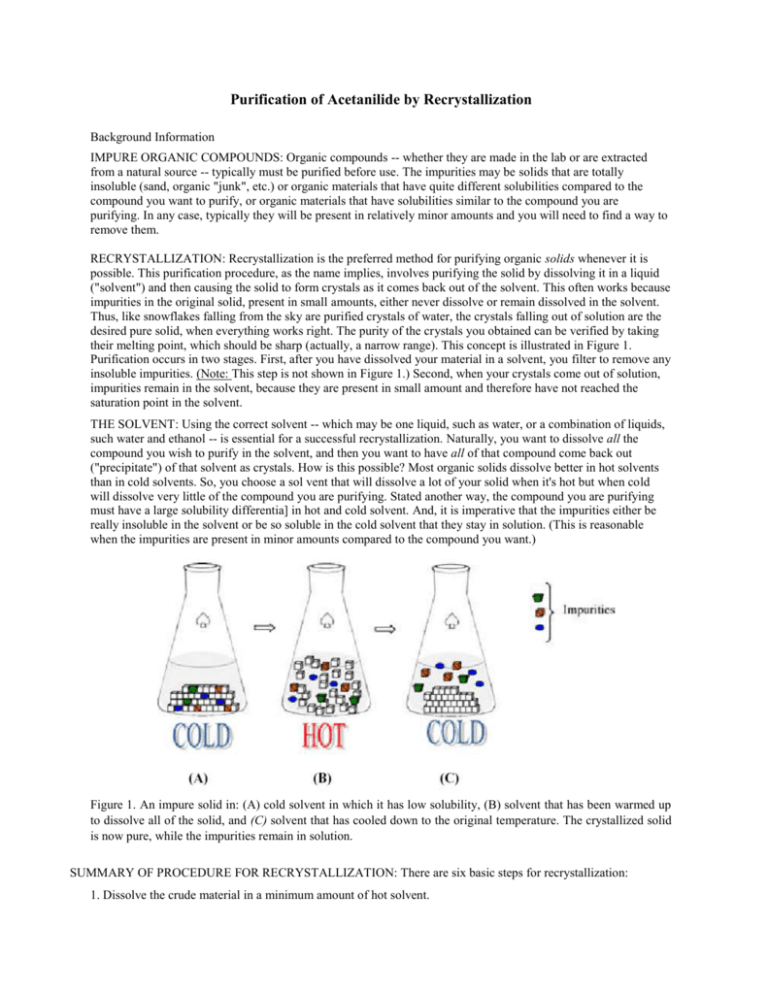
Purification of Acetanilide by Recrystallization Background Information IMPURE ORGANIC COMPOUNDS: Organic compounds -- whether they are made in the lab or are extracted from a natural source -- typically must be purified before use. The impurities may be solids that are totally insoluble (sand, organic "junk", etc.) or organic materials that have quite different solubilities compared to the compound you want to purify, or organic materials that have solubilities similar to the compound you are purifying. In any case, typically they will be present in relatively minor amounts and you will need to find a way to remove them. RECRYSTALLIZATION: Recrystallization is the preferred method for purifying organic solids whenever it is possible. This purification procedure, as the name implies, involves purifying the solid by dissolving it in a liquid ("solvent") and then causing the solid to form crystals as it comes back out of the solvent. This often works because impurities in the original solid, present in small amounts, either never dissolve or remain dissolved in the solvent. Thus, like snowflakes falling from the sky are purified crystals of water, the crystals falling out of solution are the desired pure solid, when everything works right. The purity of the crystals you obtained can be verified by taking their melting point, which should be sharp (actually, a narrow range). This concept is illustrated in Figure 1. Purification occurs in two stages. First, after you have dissolved your material in a solvent, you filter to remove any insoluble impurities. (Note: This step is not shown in Figure 1.) Second, when your crystals come out of solution, impurities remain in the solvent, because they are present in small amount and therefore have not reached the saturation point in the solvent. THE SOLVENT: Using the correct solvent -- which may be one liquid, such as water, or a combination of liquids, such water and ethanol -- is essential for a successful recrystallization. Naturally, you want to dissolve all the compound you wish to purify in the solvent, and then you want to have all of that compound come back out ("precipitate") of that solvent as crystals. How is this possible? Most organic solids dissolve better in hot solvents than in cold solvents. So, you choose a sol vent that will dissolve a lot of your solid when it's hot but when cold will dissolve very little of the compound you are purifying. Stated another way, the compound you are purifying must have a large solubility differentia] in hot and cold solvent. And, it is imperative that the impurities either be really insoluble in the solvent or be so soluble in the cold solvent that they stay in solution. (This is reasonable when the impurities are present in minor amounts compared to the compound you want.) Figure 1. An impure solid in: (A) cold solvent in which it has low solubility, (B) solvent that has been warmed up to dissolve all of the solid, and (C) solvent that has cooled down to the original temperature. The crystallized solid is now pure, while the impurities remain in solution. SUMMARY OF PROCEDURE FOR RECRYSTALLIZATION: There are six basic steps for recrystallization: 1. Dissolve the crude material in a minimum amount of hot solvent. 2. Treat with decolorizing charcoal. 3. Filter the hot solution to remove charcoal and other insoluble impurities. 4. Cool to cause crystallization. . 5. Filter the crystals, washing to remove adhering solvent and soluble impurities. 6. Dry the crystals to remove the last traces of solvent. Safety Notes! Acetone and petroleum ether are extremely flammable! Ethanol burns well. Use no flames during this lab. Acetone, pet ether, and ethanol are toxic (Yes, ethanol is toxic.) and must be used in well ventilated space only. All solvents and other materials must be discarded in the containers provided. Procedure Find a useful recrystallization solvent. Prepare a hot-water bath in a 400 mL beaker, using a hot plate for warming, and an ice-water bath in a 250 mL beaker. While you're waiting for the water bath to warm up, place ca. 100 mg of acetanilide in each of four test tubes, labeled "water", "acetone", "ethanol" and "pet ether". Add 2 mL of the appropriate solvent to each test tube and mix. For each, record whether the acetanilide dissolved significantly at room temperature. Select the test tubes with solvents that did not dissolve acetanilide, place them in the hot-water bath, and warm them to a gentle boil. For each, record whether the acetanilide dissolved significantly in the hot solvent. Allow the test tubes to slowly cool down to room temperature undisturbed. Place the test tubes in the ice-water bath to cause more complete crystallization. Record any crystal formation that you observe. Recrystallize impure acetanilide. Based on your results, select the best solvent for recrystallization of acetanilide. Check your choice with your T A, and then proceed with the recrystallization of impure acetanilide. . Set up the hot filtration apparatus as shown in Figure 2. Prepare a fluted filter (The T A will demonstrate how to fold the paper.) and put it in a stemless funnel on top of a 1 25-mL Erlenmeyer receiving flask. A few minutes before you are ready to start filtration of your hot solution, place a smalJ amount of recrystallizing solvent in the flask and warm it on a hot plate. Weigh out 1.5 g of impure acetanilide and take a second, small (about the volume of two match heads) sample for a melting point. Place the weighed sample of impure acetanilide in a 50-mL Erlenmeyer flask. Place about 50 mL of the recrystallizing solvent in a l50-mL beaker, add a boiling chip and bring the solvent to a gentle boil using a hot plate. Add about 15 mL of the hot recrystallizing solvent to the 50-mL Erlenmeyer flask containing acetanilide and bring the mixture to the boiling point. Add successive small portions of solvent,. while stirring and gently boiling the mixture, until the entire compound has dissolved. Be patient - give the solid plenty of time to dissolve before you add more sol vent. Do not attempt to dissolve insoluble impurities. (lf you add too much solvent, you will get few or no crystals at the end!) Add about 10% more solvent, remove the flask from the hot plate, and let the mixture cool about half a minute. Cautiously add about a spatula-tip full of decolorizing carbon (Be cautious! This could' cause foaming if the solvent hasn't cooled sufficiently!) and bring the mixture to a gentle boil. Make sure that the hot filtration apparatus is thoroughly warmed Lip, and then begin filtration by pouring a small portion of the solution into the funnel. (The flask is hot! Attach a clamp to use as handle while pouring the solvent out of the flask.) When most has gone through the filter, add some more. Keep the mixture at a gentle boil between additions - you want to keep it hot, but should not boil away the solvent. Hot Filtration. To remove insoluble impurities, you filter the solvent after you have dissolved the entire desired compound in hot solvent. This removes solid junk and charcoal (yes, really -- it's called "decolorizing carbon") that you added to help remove minor impurities that will stick to it. Because you're using hot solvent to dissolve your material, you must filter the solution while it is hot. If the solution cools before or while you're filtering the solution, you will lose a lot of the compound you want. Figure 2 shows the setup for hot filtration. (You don't use vacuum filtration because this would cool your solvent too quickly.) Filtration will go faster when you use folded ("fluted") filter paper. (Your T A will show you how to fold the paper.) Using a stemless funnel helps keep the solvent from cooling in the funnel. Vacuum Filtration. Once your substance has fully crystallized, you need to filter the purified crystals to remove the solvent, which carries away the impurities that are soluble in the solvent and helps remove the solvent ("dry" your crystals). Generally, this is done rapidly and effectively using vacuum filtration. The vacuum sucks the solvent away quickly and pulls air past the crystals, which are lying on a flat piece of filter paper (big enough to cover all the holes!) in the Buechner funnel, to dry them. When you have filtered all of the solution, add a small portion of fresh solvent (10% of the volume used so far) to the flask containing the remaining charcoal, and then heat to a gentle boil. A]so filter this into the flask that contains the filtrate you first collected. This will rinse your compound off the charcoal and off the filter paper, reducing the amount of acetanilide that you lose. When filtration is complete, heat the collection flask to dissolve any crystals, remove the flask from the hot plate, and let it stand undisturbed. Set up the vacuum filtration apparatus, as shown in Figure 3. Special notes: (1) Heavy vacuum hoses easily tip filter flasks, so they must be properly clamped. (2) Make sure you have the correct size filter paper. It must be big enough to cover all the holes in the Buechner funnel but small enough to lie flat inside the funnel. When the crystallizing mixture has cooled to room temperature, cool it further in an ice-water bath. Clamp your flask to hold it securely in the ice-water bath -- if it tips over (which can happen easily), you start over! Also chill some recrystallizing solvent for washing the crystals. When crystallization is complete (Let the solvent get cold.), you are ready to filter. Start the vacuum by turning the vacuum knob on the hood. Add a little solvent to the funnel to moisten the filter paper and hold it in place. Swirl the crystallizing flask a few times to suspend the crystals, and then collect the crystals by pouring the solvent and suspended crystals into the Buechner funnel. Be careful not to pour so fast that your solvent overflows! When all of the mixture has been filtered, press the crystals dry with a clean cork or spatula. Stop the vacuum and add cold solvent to just cover the crystals. Let stand for a few seconds, and then stir gently to expose all of the crystals to the wash liquid (Be careful not to disturb the filter paper!), and restart the vacuum. Press the crystals dry as before, and continue to draw air through them for 5 minutes. When the crystals are as dry as possible, gently scrape them off of the filter paper (Don't shred the paper!) onto a watch glass. Place the watch glass in a drying oven at 60°C for 10 minutes to remove the last traces of solvent. Record the weight of the purified acetanilide, and then determine the percent recovery, based on the amount of crude material used. Check the purity of your acetanilide. Determine the melting point (range, actually) of both the impure and the purified acetanilide. (You can do both at the same time.) Be certain to heat very slowly (1 - 2°C/min) in the melting range. Record the melting ranges for each. Remember to turn the temperature down when' you are finished to allow the apparatus to cool for the next person. Clean Up Show the purified material to your T A, who will tell you whether you should put it in the <'Recovered Acetanilide" container or discard it in the "Unwanted Materials" container. When you are finished, clean all glassware and dispose of all unwanted solvent and solids in the containers designated for each. Water and ethanol are the only things from this experiment that go down the drain in the sink! Report: Purification of Acetanilide by Recrystallization Your Name: _________________________________ Your Lab Partner's Name: ____________________ TA Lab Section (circle one and write in the lab meeting time) Tuesday _______ Thursday __________ Solvent Solubility Observations: Cold Solvent Hot Solvent Water Acetone Ethanol Pet Ether Recrystallization: Amount of impure acetanilide: ___________________________ g Amount of purified acetanilide recovered___________________________ g Percent recovery _____________ Melting Point: Melting point of impure acetanilide_________ °C Melting point of purified acetanilide _________ °C Crystals When Cooled? Questions 1. Did recrystallization improve the purity of your acetanilide? How can you tell? 2. Assume that your original sample of acetanilide was 90% pure. What was the maximum amount of pure acetanilide that you could recover after your recrystallization? 3. How much acetanilide did you lose during the entire recrystallization process? Where did the losses probably occur?



